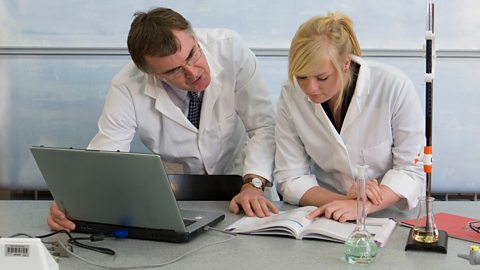Welcome to our online chemistry lab where you can learn more about changes of state. Interact with the activity to see what happens at the particle level when different substances are heated.
What are the three common states of matter?
Solid, liquid and gas are the three main states of matter. When a substance changes state, this is a physical change because no new substances are produced and the change is reversible.
The particles in solids, liquids and gases change arrangement and motion when a substance is heated or cooled. This is explained by the kinetic theory of matter.
Read more about solids, liquids and gases in our study guide about the three states of matter.
How do substances change state?
The amount of energy needed to change state depends on the strength of attraction between the particles. Substances with stronger forces of attraction will have higher melting and boiling points.
Read more about this process in our study guide about changes of state.
Higher tier only - the particle model shows all particles as solid spheres with no forces between them. In reality, atoms, molecules and ions are different shapes and sizes, so the model is simplified.
Interactive activity - changes of state
What type of change is a change of state? Use this interactive activity to find out what happens to particles inside substances when they are heated.
Choose a material from water, sodium chloride or iron and note how the melting and boiling points for these substances differ.
Test your understanding of the changing states of matter
In which state do the substances have the least energy?
Solid.
In which state is the average distance between the particles greatest?
Gas.
Between D and C on the graphs the substances are condensing. Is energy being given out to the surroundings or being taken in from the surroundings?
Energy is being transferred to the surroundings.
If a sample of sodium chloride has a temperature of 1300 °C, is it a solid, liquid or gas?
Liquid.
Based on the melting point of water, sodium chloride and iron, explain which substance has the strongest forces of attraction between the particles?
Iron, because it has the highest melting point. The structure of iron is a positive ion lattice surrounded by delocalised atoms. It takes a lot of energy to break down the lattice due to the strong forces of attraction between the positive lattice and negative electrons.
Where can I find out more about changes of state?
The BBC Bitesize study guide about changes of state contains audio, diagrams and more chemistry revision notes written to the AQA GCSE chemistry specification. Or you can explore all guides about bonding, structure and the properties of matters.
To help you revise on the go, BBC Bitesize and BBC Sounds have developed a series of GCSE revision podcasts, covering a wide range of GCSE chemistry topics. Listen to the series about bonding, structure and properties or skip straight to the episode about states of matter.

Where can I test my knowledge of the changing states of matter?
There are lots of ways to test yourself and practise your skills with Bitesize, including:
An interactive quiz to help you revise the states of matter, with video feedback to help your understanding.
A ten-question quiz on the three states of matter, including questions about changing states.
Sample exam questions covering bonding, structure and matter, with advice for multiple choice, structured, maths and practical questions.
Bitesize also has lots of general AQA chemistry test pages, including:
Exam practice quizzes based on GCSE chemistry past papers.
Quick-fire quizzes with different GCSE chemistry questions each time you return.
Topic-based exam practice questions based on past papers, allowing you to choose the GCSE chemistry topic you want to focus on.